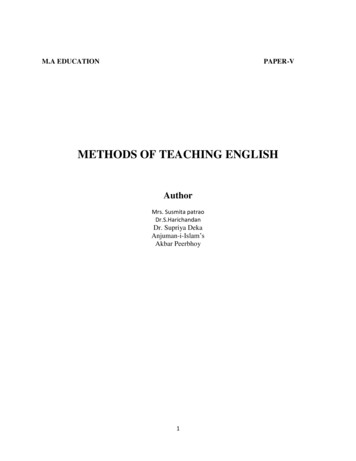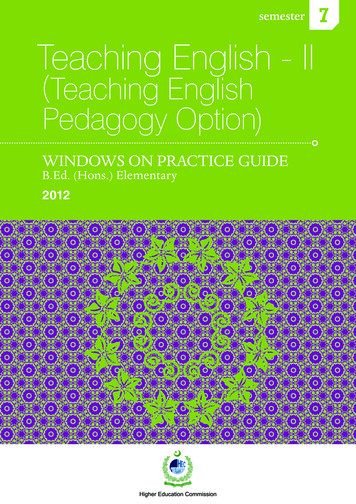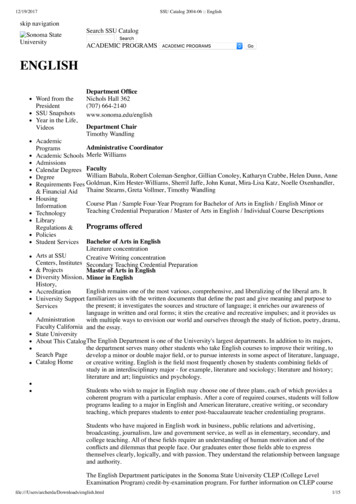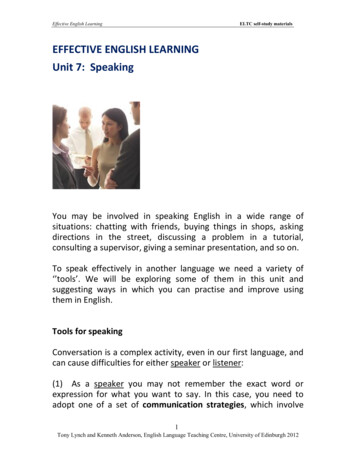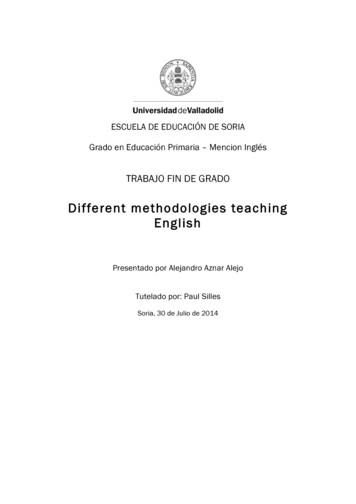
Transcription
ESCUELA DE EDUCACIÓN DE SORIAGrado en Educación Primaria – Mencion InglésTRABAJO FIN DE GRADODifferent methodologies teachingEnglishPresentado por Alejandro Aznar AlejoTutelado por: Paul SillesSoria, 30 de Julio de 2014
ABSTRACTOur aim in this paper is to establish a fresh eclectic approach to English-teachingmethodologies starting with the analysis of the existing methodologies.Following an initial analysis of the existing methodologies, we will expose theirweaknesses and we will reflect on their use. Thus, we can provide a satisfactorytheoretical framework upon which to build.Finally, we will discuss the idea of a new eclectic method that may help improvethe teaching of English with new technologies such as video games. We will also takeinto account our own experience of the “practicum” abroad in a native school.KEYWORDSDifferent methodologies, eclectic approach, video games, native teaching.2
INDEX1. Abstract 22. Keywords .23. Index .3Main Part4. Introduction .55. Objectives .66. Justification of the chosen topic 77. Theoretical precedents .98. Methodology .229. Intervention purpose .24Final Part10.Limitations and suggestions .3511.Conclusions .3612.Bibliography .3813.Annexes .393
4
INTRODUCTIONTeaching English is challenging .However, in this globalized world learningforeign languages is necessary. So as potential teachers, we should ask ourselves thefollowing questions,: How should I teach English to my pupils? What is the best wayfor them to learn?At present, English is one of the most important and growing subjects in ourprimary schools and it is also present in our curriculum. Moreover, many schools areadopting bilingual programs. Though there is abundant legislation stipulating howteachers must proceed and how they should incorporate the different approaches andmethodologies, it is the teachers themselves who are expected to design and plan thelessons.Learning a foreign language as if it were a mother tongue would be the idealway, since the need to learn grammar and structures would be obviated. This is difficultif the teachers themselves are non-native and is therefore one of the most complicatedaspects.Thus, we consider it very important to investigate how to teach English in eachsituation. Sometimes it is not a matter of teaching English but a matter of teaching inEnglish. The main purpose is to create a new method made of all the different methodsalready known and take advantage of all the positive features in each method.However, just a simple mixture of all methods would not be enough since we aredealing with very different situations regarding age, level and resources. Therefore, themain idea is to use all the methods in a varying proportion depending on thecircumstances. Learning a foreign language may cause stress and anxiety and in order tomitigate this problem, teachers could follow a Natural approach involving teaching in asetting as close as possible to the one people learn their mother tongue.5
OBJECTIVESOur aim to is draw on what we consider to be the most outstanding features ofthe existing methods to develop a fresh teaching method which is close as possible tothe native process of language acquisition.Overall Objective- Analyze what would be the most appropriate methodological guidance for theteaching of English in Primary Education, and create an eclectic method.Specific ObjectivesThe specific objectives are:- Gather information to explain in detail some of the existing methods used inthe teaching of English.- Analyze each of these methods indicating their advantages and disadvantages.- Report the most appropriate methodological guidance for the teaching ofEnglish in Primary Education.-Propose an eclectic method the closest to the native teaching way using theknown resources.6
JUSTIFICATIONAs stated earlier, at present English is crucial in our education,since it is thelanguage of the global village. It is therefore high on the list of the curricular priorities.As a potential English teacher, I am very interested in finding the best way totransmit my knowledge of English, and something very important to me is to transmitthe love for the language and make the pupils keen on learning it.Is not just a matter of accomplishing certain goals or preparing the pupils to passcertain examinations, I would like to go further and find a methodology as similar aspossible to the native one. Thus, is not just a matter of teaching English but a matter ofteaching in English, learning English through all the different daily situations andthrough the different subjects present in the school.However, in our teaching panorama, all the methods have the sameconsideration. It is the teacher’s prerogative to choose one or another. This is why Iwould like to state the advantages and disadvantages of using different methods indifferent situations. Furthermore I would like to propose a method regarding all thepossibilities of the known methods and from there, attempt to develop an eclecticmethod as similar as possible to the native one.I believe that the development of new teaching methods provides long-termbenefits for the education system as a whole. It should be a prime concern for membersof the teaching profession. If there were an ideal method for every possible situation,then every pupil would have a better chance of succeeding. It is the only possible way todevelop an English teaching method, which could be compared to the ones in the nativecountries.To sum up, the future employment of our youth depends to a great extent onbeing fluent in more than one language. In fact it is now a minimum requirement in thelabour market. Thus, both learning and teaching English are essential since is the7
official language in many countries and the language used for business and internationalrelationships.8
THEORETICAL BASE ANDPRECEDENTSAs a theoretical base and precedents, and since I have had the English TeachingMethod subject this academic year, I will follow the subject theory, in which we canfind the different English Methods used nowadays and their main characteristics.The Methods are as follows:1. The Grammar Translation Method2. The Direct Method3. The Audio-lingual Method4. The Total Physical Response5. The Communicative Language Teaching6. Task-based Language Learning7. SuggestopediaFirst of all we consider it important to define the Word methodology.METHODOLOGY: A system of ways of doing, teaching or studyingsomething (Cambridge Dictionary).According to Traits: Describes concrete ways of Teaching.Another definition: Tries to be as precise as possible giving examples of how toteach following a determined method.English Methodologies:9
1. The Grammar-Translation MethodThis was the predominant method in Europe during the nineteenth century.Some of its main proponents are Seidenstücker Johann, Johann Karl Plötz andMeidinger (Stern, 2001).It is based on learning grammar rules and vocabulary of the language. Oneof its main objectives is that students become able to translate from onelanguage to another. Reading and writing basically works, leaving aside themore oral expression and comprehension. Classes focus on the teacher, whoprovides grammar rules and vocabulary to be memorized.Grammar is taught with explanations in the native language and only laterapplied in the production of sentences through translation from one language toanother. The sentence is the basic unit of learning and practising the language.Most sessions are based on phrase translation from one language to another. Thestudent's native language is the medium of instruction, that is, it is used toexplain new items and to make comparisons between the target language and thenative language.As already mentioned, the mother tongue is kept as a reference in theprocess of learning a second language. The principles on which this methodcould be defined are based on the following points:1. Translation interprets the words and phrases of a foreign language in the bestpossible way.2. Structures of language are best learned when compared and contrasted withthe mother tongue.In this method, while the textbook is used, the teacher will translate every wordand phrase from English into the mother tongue.Translation from one language to another is a very important goal that studentsshould acquire. Authority in the classroom is the teacher and key skills to belearned are reading and writing.The main features of the Grammar Translation Method are:To Grade Elementary Teacher Project Carré Moreno, AnnaIt is a way to study the language used by the detailed analysis of grammarrules, and focuses on the translation of phrases and texts of the language beinglearned. The mother tongue remains the reference system in the acquisition of10
the second language.· Reading and writing are the main learning objectives. Reproduction andoral/listening skills received little attention.· The selected vocabulary is based on the texts used and is taught through a listof words with its translation equivalent. Students memorized.· The sentence is the basic unit of learning and practice of new language.Most lessons are based on translation into the mother tongue.· Accuracy is greatly emphasised. It is expected that students acquire competenttranslation skills· Grammar is taught deductively, through presentations and studiogrammatical rules, which are then practised through translation exercises. Theintent was to teach grammar in a systematic and organised way.· The students' native language is the medium of instruction. It is used to explainnew items and to make comparisons between the language learned and mothertongue.This method has some disadvantages, among which we highlight that it givesstudents the erroneous idea that a language is a collection of words that areisolated and independent. The method also decreases student motivation since itleads to frustration and boredom. Equal relevance is not attributed to the fourmajor skills of language learning: listening, speaking, reading and writing. Thismethod involves less preparation of didactic lectures by the teacher, andteacher's ability to speak English correctly is not taken into account. Moreover,almost no class time is allotted for students to produce their own sentences, andeven less time is spent on oral practice (productive or reproductive). Theclassroom experience does not allow students to develop theie own style. Inaddition, there is often little contextualization of grammar.As we can see, the Grammar-Translation method is very antiquated, it does notmean that we can not use it at all, but we need to consider many other issueswhile teaching to our pupils. At some point and in some circumstances theGrammar-Translation method may be useful, but in general we recommend thatit should not be over-used.11
2. The Direct MethodThe Direct Method was born in France and Germany in the late nineteenthcentury and early twentieth century and was consecrated in the United States withSauveur and Maximilian Berlitz (Richards & Rodgers, 2001). The appearance ofthis method was a response to dissatisfaction with the grammar-translation method.Its creators argue that a language can be taught without translation or the use ofthe native language if learning is based on demonstration and action. The languageis best taught using it actively in class, rather than using analytical procedures thatfocus on the explanation of grammatical rules.Teachers should encourage direct and spontaneous use of the language learnedin class. Thus, students will be able to learn the language and induce grammaticalrules. The vocabulary learned can be used to teach the new one, using mime, showsand clips.It' involves the immersion of students in the target language in the same way thatthey learned their mother tongue. It is focused on preparing students to use thelanguage in order to achieve communication. All language learning is done in thelanguage you want to learn and new learning is taught orally. The new vocabulary istaught through demonstration and focuses primarily on speaking and listening,giving much importance to correct pronunciation. Students must devote much classto oral practice.The key principles are:1. Instructions in class are made exclusively in the target language. Students mustlearn to think and communicate in the target language.2. Only learn the vocabulary and phrases every day during the initial phase of theclass. in the following phases grammar, reading and writing is introduced.3. Communicative skills are taught gradually using question-answer exchangesbetween teacher and students.4. The vocabulary is taught through demonstration, objects and images. Abstractvocabulary is taught by association of ideas.12
5. Both oral production and listening comprehension are taught.6. Correct pronunciation is emphasised.Some of its main features are:· Students must learn to think and communicate in the target language.· The role of students is not passive.· culture (history, geography, day-to-day life) of the speakers of the language isstudied.· Vocabulary is emphasised by Holm grammar.The main disadvantage of the Direct Method is that it is based on the idea thatthe target language can be learned exactly in the same way as the mother tongue.This is difficult because the conditions for second-language acquisition are verydifferent native-language acquisition. In addition, the obligation to avoid using thenative language often leads to complicated explanations in the target language.Among the other disadvantages are the rigorous basis on linguistic theory. First,the results depend excesssively on the qualities of the teacher and not all teachershave enough time to adhere to the principles of this method at a native level.Second, teaching conversation skills is not altogether practical if one takes intoaccount the time available for learning foreign languages in schools, thoughadmittedly, the method was successful in private language schools (e.g. Berlitz),where paying clients were highly motivated and the use of native teachers was thenorm. Third, in state schools it was perceived to have several drawbacks since itrequired teachers who were either native speakers or fluent in the foreign language.Finally, It was largely dependent on the teacher’s skill, rather than on a textbook,and not all teachers were proficient enough in the foreign language to adhere to theprinciples of the method.13
3. SuggestopediaThis method developed by the Bulgarian psychiatrist-educator Georgi Lozano v.The method is derived from “Suggestology”.Although Suggestopedia is arguably now out-dated, certain elements of theapproach still survive. The approach was based on the notion that positivesuggestion would make the learner more receptive and in turn, stimulate learning tosome extent. Lozanov holds that a relaxed but focused state is the perfect state for alearning process. In order to create this relaxed state, suggestopedia makes use ofmusic, a comfortable and relaxing environment, and a close relationship between theteacher and the student, almost like the parent-child relationship. Music, inparticular, is central to the approach. Unlike other methods and approaches, there isno apparent theory of language in suggestopedia and no obvious order in whichitems of language are presented.Although language-teaching materials are not used in Suggestopedia, thelearning environment plays such a central role that the important elements of theenvironment need to be briefly enumerated. The environment (the indirect supportmaterials) comprises the appearance of the classroom (bright and cheery), thefurniture (reclining chairs arranged in a circle), and the music.This is not to say, however, that certain elements of the approach cannot betaken and incorporated into the more eclectic approach to language teaching widelyin evidence today. The use of music both in the background and as anaccompaniment to certain activities can be motivating and relaxing. Attention tofactors such as décor, lighting and furniture is surely not a bad thing. Dialogues toohave their applications. Perhaps most importantly of all the ideas which createconditions in which learners are alert and receptive, can only have a positive effecton motivation. Whether these conditions are best created by the use of classicalmusic and the reading of dialogues is debatable, but there is no doubt thatSuggestopedia has raised some interesting questions in the areas of both learningand memory.14
4. The Audio-Lingual Audio-Visual MethodThe Audio-lingual Method appeared as a result of the need to possess good oral andaural mastery of a foreign language during and after World War II. We find this methodnamed in different books of the 60s. Its well-defined principles were developed byMoulton, between 1961 and 1963 (Stern, 2001).It is closely linked to behaviourism, the elements of repetition and habitformation. This method proposes a learning process based on listening and oralproduction as opposed to writing and reading.The material presented is based especially on dialogues and exercises as majorlearning techniques. In this method, the use of the mother tongue in the classroom is notrecommended, although the use of the mother tongue in the classroom or materials isnot as restrictive as it is in the direct method.The lessons are organised by grammatical structure and presented through shortdialogues. Generally students repeatedly hear different conversations and focus onmimicking the pronunciation and grammatical structures in these dialogues. Simple andactive practice is emphasised. The intention is to prevent learning the language frombeing a mental burden and make it a relative effort through repetition and imitation.The Audio-lingual Method has introduced memorising dialogues and imitativerepetition as specific learning techniques. It is an interpretation of learning in terms ofstimulus and response.The main objectives of this method are to develop oral proficiency in the languagethrough a wide choice of vocabulary, and to make the students capable ofcommunicating using language learned automatically.Its basic principles are:1. Listening and oral production should be taught before writing and reading.2. Instructions and exercises are given in the target language.15
3. Language forms occur within a context.4. Mistakes are carefully avoided because they lead to the formation of bad habits.5. The teaching methods are geared to provide students with a native-speaker model.6. Positive reinforcement helps students develop good habits.7. The teacher leads, guides and controls the learning of students in the targetlanguage.8. Language is seen as culture-related.9. Dialogue is the way to present vocabulary, structures, and is learned throughrepetition and imitation. Interaction occurs between student and teacher. Thestudent imitates the teacher.10. Importance is given to correct pronunciation, rhythm and intonation.Some of the major weaknesses of this method are:· Repetition as a learning method is used, and no opportunity is given to students tocreate anything new or be spontaneous.· Students become very good at the practice of speaking, but are unable to use thepatterns fluently in natural communication contexts.· It may be a mistake to regard audio-visual materials as a teaching method inthemselves, instead of as a a didactic tool.5. Total physical responseThe Total Physical Response method was developed by James Asher in 1960(Richards & Rodgers, 2001). It is based on the psychological theory that memory isincreased when stimulated by the association of motor activities for language learning.It refers to coordination between speech and action. It is based on learning thelanguage through physical and motor activity. This author proposes that direct speech,such as commands or orders, towards students produce physical responses before verbalresponses. The method involves playful movements, reduces stress and creates apositive mood in the student, thereby aiding the learning process.According to the author, there are 3 principles:16
1. The child develops listening skills before speaking skills in the initial phases oflanguage acquisition. At this stage, children can understand complex expressions thatthey can not produce or imitate spontaneously.2. Oral comprehension is acquired in children because they are prepared to respondphysically to spoken language in the form of orders.3. Once listening skills are acquired, speech evolves naturally and almost effortlessly.The general objective of TPR is not to teach how to speak fluently nor to teachspeaking techniques, but simply to teach how to speak.Imperatives and commands are used in activities developed for this method.They are used for physical activity and action in students. Other class activities includerole-playing and games, which focus on the kind of situations which may occur ineveryday places like restaurants, supermarkets or the home.The primary role of Students in the Total Physical Response Method is to listenand act. They listen carefully and respond physically to commands given by the teacher.The teacher’s role is active and s/he is the leader throughout the activity. It is the teacherwho decides what to teach, which materials to use and how to use them. S/he isresponsible for providing students with the most appropriate exposure to language typesso that they can internalise the basic rules of the target language.To give feedback to the students, the teacher should follow the example offeedback that parents give their children. At first the parents correct very little, but asthe children grow up, the children tolerate fewer mistakes in speaking. Thus, the teachermust avoid over-correcting in the early ages and avoid interrupting the students withcorrections since this may inhibit them.In the early stages of learning, the teacher's voice, actions and gestures can besufficient for the class activities. As the course develops, the teacher will need morematerials to support learning.Here are written some of the instructions that the teacher can give during class:Touch your teeth.17
Show your teeth to Laura.Laura, point to Carlos' teeth.Some disadvantages of this method are:. Students may feel uncomfortable with certain exercises. This method is more suitable for beginners and younger ages. You cannot teach all the skills of a language through this method. If over-used, it canbecome repetitive.6. Communicative Language TeachingAccording to Richards and Rogers (2001), a group of renowned linguists, such asWiddowson, Candlin, Christopher Brumfit and Keith Johnson, among others, all ofwhom are well-known for their work in this field, contributed to the CommunicativeTheory Method on the basis of work carried out by linguists such as Firth and Halliday.Great importance is given in helping students to use the language learned in avariety of contexts. Particular emphasis is also placed on learning language functions,especially the communicative function. They believe that the main goal in the learningprocess is the acquisition adequate skills in the use of language as a means ofcommunication.The main focus is on helping students to create meaning as opposed to helpingthem to acquire precise grammatical structures or acquire a level similar to that of anative. It is aimed for students to acquire the language by focusing on the developmentof communicative competence. To achieve this goal, teachers use materials that focuson the need to express and understand.The main objectives of this method are:1. The development of communicative competence in students2. Involving students in the learning process18
3. Giving equal emphasis to the four language skills: speaking, listening, readingand writing.Key Principles of the Method.1. The language should be submitted as used in actual cultural context.2. Learned language should be the vehicle of communication in class.3. Pupils should be given the opportunity to express their ideas and opinions.4. Errors are seen as a normal process in the development of communication skills.5. Fluency is more important than accuracy.6. One of the responsibilities of the teacher is to create situations that promotecommunication.7. An additional function of the teacher is to foster student learning in the role ofactivity manager and communicative advisor.In this method, the student has the central role and the teacher acts as a mediator.Teachers talk less and listen more, thereby actively fostering student learning. Theteacher provides motivation for the students to work with the language.According to Communicative Language Teaching method, language is used in fourdifferent ways. These ways are also called competences:- The discursive competence: refers to the student's ability to use the new languagein speaking and writing. Teachers often call this skill fluency.- Grammatical competence: refers to the ability to use the language correctly, usingthe rules and features of the new language. This competence is also often calledprecision.- Sociolinguistic competence: the student's ability to use language correctly inspecific social situations. It is also known as adequacy.- Strategic competence: refers to strategies for effective communication when thestudent's vocabulary is insufficient and requires learning strategies. It is also known asefficacy.19
The Communicative Language Teaching Method has certain disadvantages. First,more vocabulary is required to support the functional use of language. Second, itprovides few guidelines on how to handle the vocabulary. Third, according to somereviews, it over-emphasises the concept of communication. And finally, it is difficult toadopt a communicative learning approach if there are so few native teachers.7. Task-based language learningThis approach was created by Prabhu (1987) and was created to fill the gaps of thecommunicative approach (Richards & Rodgers, 2001). It tries to define what should betaught from an analysis of language as a tool for communication, not as a formalsystem.It is based on an approach where various tasks as the central unit of planning inlearning the language are used. It is based on the following principles:1. Activities that involve real communication are essential for language learning.2. Activities in which language is used for carrying out meaningful tasks promotelearning.3. Language that is meaningful to the learner supports the learning process.4. It focuses on process rather than product.5. Tasks in communication and meaning are essential.6. Students learn the language through communicative and intentional interaction.7. Activities and tasks are sequenced according to their level of difficulty.8. It focuses on how to get students to acquire communicative competence throughwhich they act and communicate in a real way in the target language.It is an organisation based on teaching communicative activities that integrate andpromote different processes related to communication. In the classroom students mustalso deploy other strategies used to solve specific problems in relation to the proposedtask. It focuses not on syntactic structures or functions but on activities using thelanguage. And since learning processes necessarily include communication processes,then the approach aims to promote learning through actual use of the language being20
learned in the classroom, going beyond the manipulation of units of different levels ofdescription.Thus, the task-based approach stems from a need to discover the principles thatshould govern communication, how it can be learned and how to teach.The main features of this approach are as follows:1. It is representative of communication processes in real life.2. It involves all students in understanding, producing or interacting in thetarget language.3. It is intentionally directed towards language learning.4. During the activity, the student's attention is more focused on handlinginformation (meaning) in the form (linguistic content).5. Development involves some educational values (autonomy, creativity,responsibility and reflection on the learning process).It is important to consider the content of the tasks to make this approach moreefficient. Tasks have a pedagogically appropriate structure. They are open in theirdevelopment and outcomes and in the active involvement and personal contributions ofstudents. Priority attention must be given to the response of the students to the tasks.This method has some disadvantages, including the risk that, as with all workinggroups, some students may take a secondary role and rely on others to do most of thework and learning. A second weakness is that the newly-acquired knowledge can be lostif there is no consolidation and assimilation work during the session . A third obstacle isthe difficulty of implementing task-based learning where classes are large with thelimited and insufficient space.21
METHODOLOGYIn learning a second language, the teacher must know the different methods ofteaching and learning of this language. This will help him to know which method toapply in each context. Teaching a foreign language involves many different methods.There is no recommended method for learning a second language, but some seem moreappropriate than others.As mentioned earlier, the main aim of this work is to develop am eclectic approachthrough the analysis of existing methodologies coupled with our own experiencesstudying abroad in an internship in a bilingual school where English was taught bynatives. The aim, at all times, was to develop an approach as similar as possible to theapproaches used by natives.We have summarised the existing methodologies We have seen their maincharacteristics and we
the existing methods to develop a fresh teaching method which is close as possible to the native process of language acquisition. Overall Objective - Analyze what would be the most appropriate methodological guidance for the teaching of English in Primary Education, and create an eclectic
